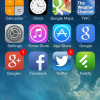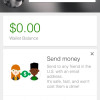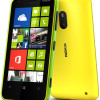Review: Apple iPhone 4S for AT&T
Screen
The iPhone 4S carries over the same 3.5-inch Retina Display from the iPhone 4. The display looks as stunning as it did last year. Packing 960 x 640 pixels into such a tiny space means it still has a higher pixel density than most other phones. It is bright, colorful, and amazingly sharp. It's not so great outside, however, and often becomes unusable in bright sunshine. I'd also be lying if I said I was satisfied with the size. I was hoping Apple would bump up the dimensions of the display a bit. With most Android phones offering 4-inch+ displays, it's sometimes hard to find satisfaction in the iPhone 4S's 3.5-inch display.
Signal
I tested the AT&T version of the iPhone 4S, and not the Sprint/Verizon CDMA versions. The iPhone 4S works on all three carriers' 3G networks. With the Sprint/Verizon variants, data speeds are limited to 3.1Mbps under optimal EVDO Rev. A conditions. With the AT&T version, data speeds top out at a more sprightly (theoretical) 14.4Mbps — if all the right conditions come together (phone + capable tower + enhanced backhaul all in one spot).
In the few days that I've been testing the iPhone 4S in New Jersey and environs, it never surpassed the 4-6Mbps average download speeds that the iPhone 4 is also capable of achieving. This means I never tested it under the optimal conditions available from AT&T. It did, however, find the network quickly, and remained connected without fail. Data speeds were quite good. The iPhone 4S did not drop any calls during my review period, nor did it miss any. It survived the NJ vault test (the local super market), where the iPhone 4 failed. It also does not succumb to "death grip." Grab it any way you like, you won't see the signal degrade. Bottom line: the antenna is improved.
The iPhone 4S doesn't have any sort of real 4G inside. That means the WiMax and LTE smartphones on Sprint's and Verizon's networks, respectively, will offer faster data speeds. The 4S does not work with AT&T's LTE network.
Sound
The iPhone 4S takes yet another step towards becoming a serviceable voice phone. First, the earpiece produces the most volume of any iPhone so far. That means it will be easier to hear conversations in noisy places. Most phone calls were relatively clear of interference, but I noticed some scratchiness from time to time. In general, though, call quality is easily better than the iPhone 4. The speakerphone is also louder, though at maximum volumes I found it is more prone to distortion. The ringers and alert tones can be set to excellent levels, and the vibrate alert is stronger than previous iPhones.
Battery
Whoa, what the hell happened, Apple? I found battery life of last year's iPhone 4 to be excellent. Not so with the iPhone 4S. Apple claims that the iPhone 4S lasts longer for most usage (talk time, music playback, video playback, browsing), but will use more during stand-by time. This is absolutely true. At night, the iPhone 4S routinely loses 10% of its charge — even when not being used at all. For comparison sake, the iPhone 4 typically lost 1% of its charge overnight. Power evaporates really quickly if you don't properly manage your notifications. I found that turning off certain types of notifications and when/where they appear seems to help improve battery life a little bit.
Bottom line: some users may struggle to get through a whole day. I am able to, but that's only because I spent hours fine-tuning the settings. Charge it every night, no matter what.


 Review: Apple iOS 7 from A to Z
Review: Apple iOS 7 from A to Z
 Google Makes Wallet App Available to iPhone
Google Makes Wallet App Available to iPhone
 Microsoft Brings Office to the iPhone, But Not for Free
Microsoft Brings Office to the iPhone, But Not for Free
 Google+ for iOS Updated with New Photo Tools
Google+ for iOS Updated with New Photo Tools
 Aio Wireless Kicks Off Today with Nokia Lumia 620
Aio Wireless Kicks Off Today with Nokia Lumia 620
 Apple iPhone 4S
Apple iPhone 4S



